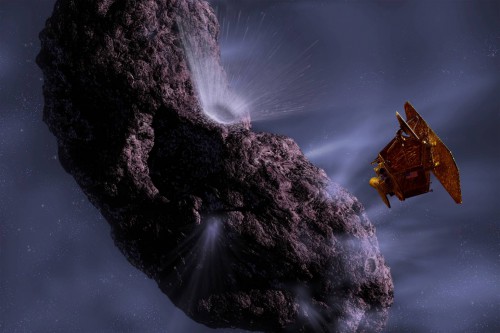
Deep Impact, the spacecraft that sent an impactor into the crust of Tempel 1, is now taking aim (in an imaging sense) on comet C/2012 S1 (more commonly known as ISON). The spacecraft used its Medium Resolution Imager to snap photos of the comet between Jan. 17–18 of this year.
Deep Impact was some 493 million miles (793 million kilometers) away from the comet when it took the pictures. Researchers are hopeful that ISON will put on a spectacular show as it makes its way through the solar system this fall.
Deep Impact has already conducted close flybys of not only Tempel 1, but Hartley 2 as well. The spacecraft has also performed observations of comet Garradd—and now of ISON.

“This is the fourth comet on which we have performed science observations and the farthest point from Earth from which we’ve tried to transmit data on a comet,” said Tim Larson, project manager for the Deep Impact spacecraft at NASA’s Jet Propulsion Laboratory in Pasadena, Calif. “The distance limits our bandwidth, so it’s a little like communicating through a modem after being used to DSL. But we’re going to coordinate our science collection and playback so we maximize our return on this potentially spectacular comet.”
The work Deep Impact is doing at ISON revolves around gaining infrared data as well as information on light curves. Light curves are beneficial in determining the comet’s rate of rotation. Deep Impact is also acquiring natural light images of ISON as well.
NASA has used the imagery from Deep Impact to produce a video which can be seen here: ISON
ISON’s tail extends approximately more than 40,000 miles (64,400 kilometers) from the base of the comet. Comets like ISON are known as “long period” comets due to the fact that their orbits cover vast tracks of stellar territory. ISON is thought to originate from the Oort Cloud, an enormous spherical cloud of debris left over from the formation of the solar system. The Oort Cloud is believed to extend out to nearly one-third of the distance to the star closest to our sun.

ISON is a newly-discovered comet, having been found by two Russian astronomers on Sept. 21, 2012. NASA’s Near-Earth Object Program Office plotted ISON’s course after its discovery and believe that the comet is more-than-likely making its first trek through our solar system. Given this fact, the comet’s pristine surface stands a good chance of putting on quite a show here on Earth—that is, so long as ISON doesn’t break up before we have a chance to view it. For fans of movies such as Armageddon and (aptly named) Deep Impact, fear not—ISON stands zero chance of impacting our home world.
The Deep Impact mission was launched in January 2005. After it traveled some 268 million miles (431 million kilometers), it arrived at its first target—comet Tempel 1. In July 2005, Deep Impact sent its impactor to be “run over.” It did not disappoint. Video compiled from images from the Deep Impact spacecraft show the result of the July 4 impact.
Since that time Deep Impact has been placed on an extended mission dubbed Extrasolar Planet Observation and Deep Impact Extended Investigation EPOXI. During this period Deep Impact has researched the three other comets highlighted above (Hartley 2, Garradd, and ISON). The spacecraft’s odometer is currently at 4.39 billion miles.




GREAT ARTICLE….VERY INFORMATIVE!! Almost NOBODY knows this is happening….I’ll “Share” !! THANK YOU!!